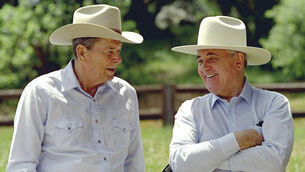November is a time for remembering

A lone walker in Belleek Woods, Ballina, embraces nature's autumnal colours as they still magically grace the landscape in the winter month of November. Picture: Henry Wills Archive
An unspoken but obvious change in attitude in recent times is the new regard most people now have for the care of family graves. Not too long ago, many cemeteries were neglected and overgrown signalling what seemed almost a studied disinterest - even though generally this is not the case. Most of our graves are cared for or at least marked in some way but now cemeteries have captured our attention - though some of the improvement can be overdone.
In any case, in recent times cemeteries have come into their own. We seem peculiarly drawn to them, even to cemeteries with which we have no direct connection. We move along the graves and ponder the limited words that summarise a lived life – people we knew, some contemporaries who have gone to God before their time, so many who didn’t make it to the threescore and ten years that Scripture (Psalm 90, verse 10) allocates to a lived life.
During the ‘month of the dead’ as we call November, something elemental moves within us, drawing us to cemeteries, where we find ourselves standing at the graves of our own dead as well as those of neighbours and friends and others we knew. It’s like visiting friends from our past and having conversations with them in the hope that somehow they can still hear us and that one day we will meet again.
Often after we lose loved ones, we find visiting graves difficult. We wonder about their bodies in the cold ground. We search for reassurance that they are not there and our Church reminds us, in a compelling phrase, that it is just ‘their remains’ that we bury. The ones we loved are not there but are with us.
The philosopher and mystic, John O’Donohue, put it this way: “Our friends among the dead now live where time and space are transfigured. They behold us now in ways they never could have when they lived beside us on earth. Perhaps one of the surprises of death will be a retrospective view of the lives we lived here and to see how our friends among the dead clothed us in weave after weave of blessing."
In the early months of grief that’s hard to square with our feelings but with time it makes sense and the atmosphere all around us helps us to make sense of the cyclical nature of life and death. There’s a rhythm to it all like the turn of the seasons of the year - spring, summer, autumn, winter. And remembering our dead is sensed too as a winter moment that moves another year to a conclusion.
By common consent, Irish people are good at funerals. We’re good at paying our respects to the dead. We recognise too how important it is to give moral support to the bereaved. And we still turn out to funerals in quite extraordinary numbers. It’s no surprise that the death notices on Midwest Radio has the highest listenership of the day. It fits in with the feel for the rituals of death and burial that are thankfully still part of our changing culture. And our feel for November is still very sure. The Holy Souls have this part of the Christian calendar all to themselves.
Maybe it’s because there’s something very sombre about November. It seems to bring with it a resonance of things ending and dying. Nature has worked its way through the promise of spring, the highpoint of summer, the gathering of autumn and then it packs its bag for the deadening feel of winter. The leaves scattered under our feet in November are a silent anthem for the decline of another year. So it’s no coincidence that this is the month we allocate to remembering our beloved dead.
November, above all, is a commemoration of our faithful departed, a time for remembering. And memory sweeps up the scattered leaves of time and we pick through them to choose the memories that satisfy us or trouble us: the places, the events and especially the people who have shaped and formed us and drift into our consciousness at this time of the year.
Of course, memory can deceive. Retrospect is not always an infallible guide and can serve to camouflage reality. Memory can be a sieve that refuses to allow us to remember some bits of the truth that may too painful to recollect in any kind of tranquillity. The writer, Anthony Burgess, summed it up in a memorable sentence: ‘The truth’, he wrote, ‘is fabled by the daughters of memory, and the words with which we sometimes describe the past can disguise the truth.'
However, in calmer, more tranquil November days, we facilitate the past as we turn over the events of years past in our minds. November is that more real time of year, before we get swamped in an often shallow Christmas cheer. We allow time and space to focus our remembering, searching for a face in the mind’s eye, re-telling almost forgotten stories, dredging the memory to force a recall of times and people fading into the distance.
Our thoughts naturally turn to our own departed loved ones and the discomfiting approach of our own deaths. And we do this not just to echo the message that nature sends to us with the coming of winter. We do it to put shape on life, in the telling phrase ‘to remember, less we forget’.
So this November be good to yourself. Give yourself time to remember your dead because, in a real sense, it’s what November is for – not the ghosts and ‘trick and treats’ that a lucrative industry peddles to fill in a vacuum. That’s for children. November is for adults. It’s made of sterner stuff.






